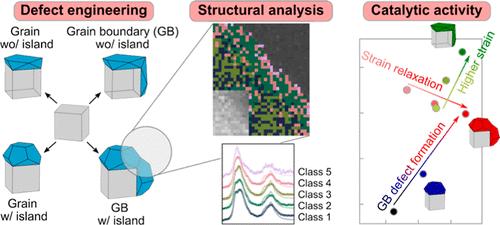基于多尺度电子结构表征的多粒纳米催化剂工程设计原则
IF 7
2区 材料科学
Q2 CHEMISTRY, PHYSICAL
引用次数: 0
摘要
工程晶界应变为调整纳米晶体的催化性能提供了一条有前途的途径。然而,随机晶粒取向和几何结构的非均质性限制了清晰的结构-性能相关性。本研究利用多晶Co3O4/Mn3O4核/壳纳米晶体平台作为模型系统,系统研究了GBs的几何失配应变如何作为氧还原反应的催化活性位点。通过对晶粒形貌的精确亚纳米级控制和集成多尺度电子结构表征,我们识别了GB缺陷的电子结构特征,并建立了局域应变场与修饰电子态之间的直接关联。GBs下的应变调制改变了eg轨道的能级,与纯剪切应变下观察到的不稳定相反,沿z轴的延伸结合剪切应变使eg状态稳定。与应变松弛晶粒表面相比,这种稳定机制提高了应变gb的电催化活性和选择性。此外,我们发现GBs表现出径向应变梯度,产生空间能量位移,进一步调制局部电子结构,通过电子能量损失谱数据的分类来解决。总之,这些发现表明,几何失配应变能够精确调整晶粒几何形状和由此产生的电子结构,为下一代纳米催化剂的工程设计提供了强有力的策略。本文章由计算机程序翻译,如有差异,请以英文原文为准。

Design Principles in Engineering of Multigrain Nanocatalysts via Multiscale Electronic Structure Characterization
Engineering grain boundary (GB) strain provides a promising pathway to tune the catalytic properties of nanocrystals. However, structural heterogeneity from random grain orientation and geometry has limited clear structure–property correlations. Here, we utilize a multigrain Co3O4/Mn3O4 core/shell nanocrystal platform as a model system to systematically investigate how geometric misfit strain at GBs serves as catalytically active sites for the oxygen reduction reaction. Through precise subnanometer-level control over grain morphology and by integrating multiscale electronic structure characterization, we identify the electronic structural signature of GB defects and establish a direct correlation between localized strain fields and modified electronic states. Strain modulation at GBs alters the eg orbital energy levels, with elongation along the z-axis combined with shear strain stabilizing the eg states, in contrast to the destabilization observed under pure shear strain. This stabilization mechanism enhances the electrocatalytic activity and selectivity of strained GBs compared with strain-relaxed grain surfaces. Furthermore, we reveal that GBs exhibit a radial strain gradient, producing a spatial energy shift that further modulates local electronic structures, as resolved through the classification of electron energy loss spectroscopy data. Together, these findings demonstrate that geometric misfit strain enables precise tuning of grain geometry and the resulting electronic structures, offering a robust strategy for engineering next-generation nanocatalysts.
求助全文
通过发布文献求助,成功后即可免费获取论文全文。
去求助
来源期刊

Chemistry of Materials
工程技术-材料科学:综合
CiteScore
14.10
自引率
5.80%
发文量
929
审稿时长
1.5 months
期刊介绍:
The journal Chemistry of Materials focuses on publishing original research at the intersection of materials science and chemistry. The studies published in the journal involve chemistry as a prominent component and explore topics such as the design, synthesis, characterization, processing, understanding, and application of functional or potentially functional materials. The journal covers various areas of interest, including inorganic and organic solid-state chemistry, nanomaterials, biomaterials, thin films and polymers, and composite/hybrid materials. The journal particularly seeks papers that highlight the creation or development of innovative materials with novel optical, electrical, magnetic, catalytic, or mechanical properties. It is essential that manuscripts on these topics have a primary focus on the chemistry of materials and represent a significant advancement compared to prior research. Before external reviews are sought, submitted manuscripts undergo a review process by a minimum of two editors to ensure their appropriateness for the journal and the presence of sufficient evidence of a significant advance that will be of broad interest to the materials chemistry community.
 求助内容:
求助内容: 应助结果提醒方式:
应助结果提醒方式:


